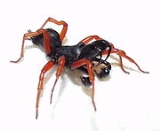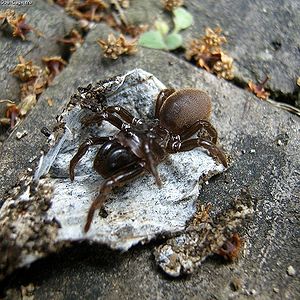
Atypical tarantula
Encyclopedia
The atypical tarantulas or purseweb spiders (family Atypidae) consist of only three genera
. Purseweb spiders are accomplished ambush predators that spend most of their time in a sock-like, silken retreat on the ground from where they kill their prey.
these are Sphodros and Atypus, in Asia and Africa there are Atypus and Calommata, and only Atypus in Europe
.
Atypus affinis, A. muralis and A. piceus are the only species of this family found in northwestern Europe.
 Atypus builds a silken
Atypus builds a silken
tube parallel to the surface of the ground. While up to 8 cm of the tube lie on the ground, about 20 cm are buried vertically. The spider rests at the bottom of the tube. When prey walks on the exposed part, the spider, alerted by the vibrations, stabs it through the silk, cuts the web and drags it inside to be eaten. Calommata, instead of building a purse web, lives in a burrow.
Sphodros usually props its tubes against a tree trunk.
Atypical tarantulas have huge chelicerae
for their size and relatively long spinnerets (although not as long as those found in diplurids
). The males are sometimes brightly colored and wander around looking for females in their tubes. The females are reddish-brown or dark-colored.
During the breeding season for Atypus affinis the male leaves his own burrow and goes in search of females. When he finds the burrow of a female he tentatively taps on the wall of the purse web and if the female is receptive he ventures into the confines of the burrow. The two spiders mate and they will cohabit until the male dies at which point the female eats him. The female makes an egg sac and hangs it in her burrow. It is not until the next Summer that the eggs hatch and it is not until the Spring after that the spiderlings leave their mother's burrow and wander off to find a suitable place to build a lair of their own.
Southeast Asian Atypus species have a body length of 7 to 21 mm in females, and about 12 mm in males. Calommata of this region grow from 23 to 30 mm in females, and only about 7 mm in males.
Genus
In biology, a genus is a low-level taxonomic rank used in the biological classification of living and fossil organisms, which is an example of definition by genus and differentia...
. Purseweb spiders are accomplished ambush predators that spend most of their time in a sock-like, silken retreat on the ground from where they kill their prey.
Distribution
In the North AmericaNorth America
North America is a continent wholly within the Northern Hemisphere and almost wholly within the Western Hemisphere. It is also considered a northern subcontinent of the Americas...
these are Sphodros and Atypus, in Asia and Africa there are Atypus and Calommata, and only Atypus in Europe
Europe
Europe is, by convention, one of the world's seven continents. Comprising the westernmost peninsula of Eurasia, Europe is generally 'divided' from Asia to its east by the watershed divides of the Ural and Caucasus Mountains, the Ural River, the Caspian and Black Seas, and the waterways connecting...
.
Atypus affinis, A. muralis and A. piceus are the only species of this family found in northwestern Europe.
Biology

Spider silk
Spider silk is a protein fiber spun by spiders. Spiders use their silk to make webs or other structures, which function as nets to catch other animals, or as nests or cocoons for protection for their offspring...
tube parallel to the surface of the ground. While up to 8 cm of the tube lie on the ground, about 20 cm are buried vertically. The spider rests at the bottom of the tube. When prey walks on the exposed part, the spider, alerted by the vibrations, stabs it through the silk, cuts the web and drags it inside to be eaten. Calommata, instead of building a purse web, lives in a burrow.
Sphodros usually props its tubes against a tree trunk.
Atypical tarantulas have huge chelicerae
Chelicerae
The chelicerae are mouthparts of the Chelicerata, an arthropod subphylum that includes arachnids, Merostomata , and Pycnogonida . Chelicerae are pointed appendages which are used to grasp food, and are found in place of the chewing mandibles most other arthropods have...
for their size and relatively long spinnerets (although not as long as those found in diplurids
Dipluridae
Funnel-web tarantulas , are a group of spiders in the infraorder Mygalomorphae, that have two pairs of booklungs, and chelicerae that move up and down in a stabbing motion...
). The males are sometimes brightly colored and wander around looking for females in their tubes. The females are reddish-brown or dark-colored.
During the breeding season for Atypus affinis the male leaves his own burrow and goes in search of females. When he finds the burrow of a female he tentatively taps on the wall of the purse web and if the female is receptive he ventures into the confines of the burrow. The two spiders mate and they will cohabit until the male dies at which point the female eats him. The female makes an egg sac and hangs it in her burrow. It is not until the next Summer that the eggs hatch and it is not until the Spring after that the spiderlings leave their mother's burrow and wander off to find a suitable place to build a lair of their own.
Southeast Asian Atypus species have a body length of 7 to 21 mm in females, and about 12 mm in males. Calommata of this region grow from 23 to 30 mm in females, and only about 7 mm in males.
Genera
- AtypusAtypusAtypus or Purse web spiders is a genus of mygalomorph spiders. It occurs in Eurasia, with one species reaching into North Africa, and one species in the USA. Only three of the described species occur in Europe: A. piceus, A. affinis and A...
LatreillePierre André LatreillePierre André Latreille was a French zoologist, specialising in arthropods. Having trained as a Roman Catholic priest before the French Revolution, Latreille was imprisoned, and only regained his freedom after recognising a rare species he found in the prison, Necrobia ruficollis...
, 1804 — Britain to Ukraine, Asia, North Africa, USA (29 species) - Calommata LucasHippolyte LucasPierre-Hippolyte Lucas was a French entomologist.Lucas was an assistant-naturalist at the Muséum national d'Histoire naturelle. From 1839 to 1842 he studied fauna as part of the scientific Commission on the exploration of Algeria.His brother was Prosper Lucas.-Works:*Histoire naturelle des...
, 1837 — Asia, Africa (7 species) - SphodrosSphodrosSphodros is a genus of mygalomorph spiders that occurs in the USA and Mexico. Its species were removed from genus Atypus and put in its own genus in 1980.-Species:* Sphodros abboti Walckenaer, 1835 — USA...
WalckenaerCharles Athanase WalckenaerBaron Charles Athanase Walckenaer was a French civil servant and scientist.-Biography:Walckenaer was born in Paris and studied at the universities of Oxford and Glasgow. In 1793 he was appointed head of the military transports in the Pyrenees, after which he pursued technical studies at the École...
, 1835 — USA, Mexico (7 species)

